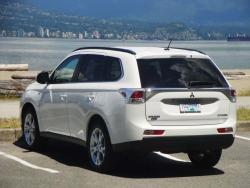 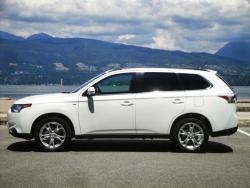 2014 Mitsubishi Outlander GT S-AWC Navi. Click image to enlarge |
Review and photos by Greg Wilson
Perhaps Mitsubishi didn’t get the memo: V6s are out; turbo fours are in.
Other manufacturers of compact SUVs have been rushing to replace their optional V6 engines with more economical turbocharged fours (Escape, Sportage, Santa Fe), or even abandon their sixes altogether (Tucson, RAV4) – but Mitsubishi has decided to keep their optional 3.0L V6 (with minor changes) in the redesigned 2014 Outlander. A revised 166-hp 2.4L single overhead cam four is still the standard engine in the base Outlander ES 2WD and ES AWC trims but the 227-hp 3.0L V6 remains standard in the SE AWC and GT S-AWC trims. It wouldn’t be difficult for Mitsubishi to replace their V6 with the 237-hp 2.0L turbo four found in the Lancer Ralliart, so why don’t they?
There are a few good reasons, actually. Currently, 70 percent of Outlander buyers choose the V6 engine over the base four-cylinder. The 3.0L six is quiet, smooth and powerful, and combined with the standard six-speed automatic transmission, delivers a more linear power progression than the Outlander’s standard four-cylinder/CVT combination. Autos.ca contributor Lesley Wimbush had similar impressions in her First Drive of the 2014 Outlander in March. Minor changes to the V6 this year include new high ignition spark plugs, moving parts with reduced friction, and an improved exhaust system, while the standard six-speed automatic has a revised torque converter and a new final drive ratio for better highway fuel economy.
As well, a new driver-selectable Eco mode alters transmission shift points, reduces air conditioning, and operates the all-wheel drive system in front-wheel drive more of the time to save fuel. An Eco leaf display in the instrument cluster grows more leaves the more efficiently you drive.
The V6’s fuel economy has improved by about nine percent to 11.8 city/8.4 highway (EPA rating). My test vehicle’s onboard average fuel consumption display was showing between 10 and 12 L/100 km in mostly city driving, similar to the EPA rating. That may not sound great, but when compared to competitors’ V6 and turbo-four motors, Mitsubishi’s V6 stands up well. For example, the Chevrolet Equinox AWD V6 is rated at 14.7 /10.2, the Ford Escape AWD Titanium 2.0L turbo is 11.2 city/8.4, the Subaru Forester AWD 2.5L turbo is 12.4 /9.8, and the Kia Sportage SX AWD 2.0 turbo is 11.8/9.4. So yes, Mitsubishi’s V6 gets better fuel economy than many of its turbocharged four-cylinder competitors.
Lastly, but not ‘leastly’, the V6’s towing capacity of 1,588 kg (3,500 lb) vs 680 kg (1,500 lb) for the four-cylinder motor is a big selling point for utility and recreational trailer towers.
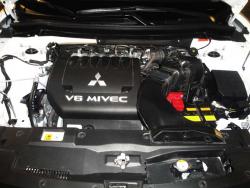 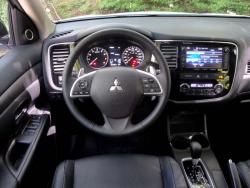 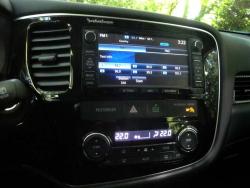 2014 Mitsubishi Outlander GT S-AWC Navi. Click image to enlarge |
Of course, if you’re willing to give up the V6 engine’s power and refinement, you can find better fuel economy in the Outlander’s base I4 and CVT combination, which has improved fuel economy by about 10 percent – 9.8 city/8.1 highway. We’ll be doing a full test drive of the four-cylinder Outlander at a later date.
While base ES 2WD Outlanders come with front-wheel drive, ES AWC and SE AWC models offer Mitsubishi’s All-Wheel Control system while GT S-AWC models feature Mitsubishi’s more sophisticated Super All-Wheel Control. Mitsu’s improved AWC system uses additional engine, transmission, steering, g-force and yaw rate sensors to determine the distribution of torque from front to rear wheels. Same goes for the S-AWC system, which also includes an active front differential that allocates torque from side to side in the front as well. As well for 2014, both AWC and S-AWC feature the new driver-selectable Eco mode for improved fuel economy.











